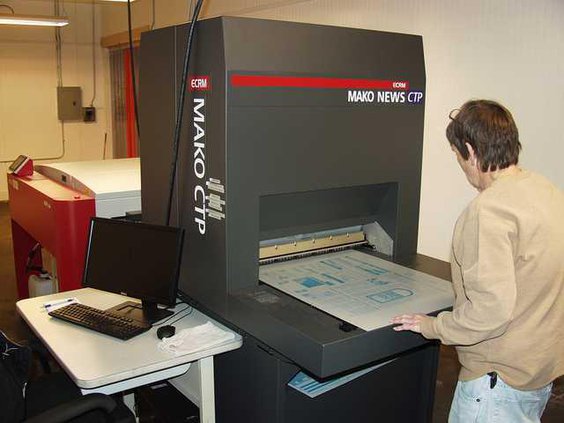Text, photos and artwork appearing on the pages of the Great Bend Tribune have been sharper of late, thanks to an upgrade to a new method of making its plates – the computer-to-plate system.
“This catches us up to the leading edge of print technology,” said Tribune Publisher Mary Hoisington. “In an age of increased digital workflow, this CtP process allows us to bring a better print product to our readers.”
First, a little background is in order.
Each page of the newspaper is created digitally in a desktop publishing software and has to be transferred to an aluminum plate which is placed on the press. It is the plates that transfer the images to newsprint.
With the older technology, computer to film, the computer file was burned onto photographic film. This film was then used to make a printing plate, in a similar manner to a contact proof in darkroom photography.
However, with computer to plate, an image is output directly to a printing plate with a laser. Then, at the Tribune, this plate is processed with a chemical-free processor.
Hoisington said CtP has several advantages over conventional platemaking. In CtP, one generation (transfer of film image to the printing plate) is removed from the printing process (eliminating the need for film and related developer chemicals), increasing sharpness and detail. Plus, with the addition of a chemical-free processor, the need for any hazardous chemical is eliminated.
CtP avoids potential losses in quality that may occur during film processing, including scratches in the film, variations in the exposure or human error in film alignment. Plates are produced in less time, are more consistent, and are environmentally-friendly. CtP can also improve registration and image repeatability.
The Tribune’s CTP machine comes from ECRM Imaging Systems, Tewksbury, Mass. ECRM stands for Electronic Character Recognition Machinery.
Its chemical-free plate processor is made by Agfa.
This investment is part of an ongoing effort by the Tribune to update production and distribution processes. “The Tribune is the main source of news, information and advertising for many of the communities we serve.” Hoisington said. “By investing in our equipment, facilities and employees, we will be able to better meet the future needs of our readers and advertisers.”
The Tribune has been serving Great Bend and the surrounding communities since 1876.
Taking the next step
New system improves Tribunes print quality





